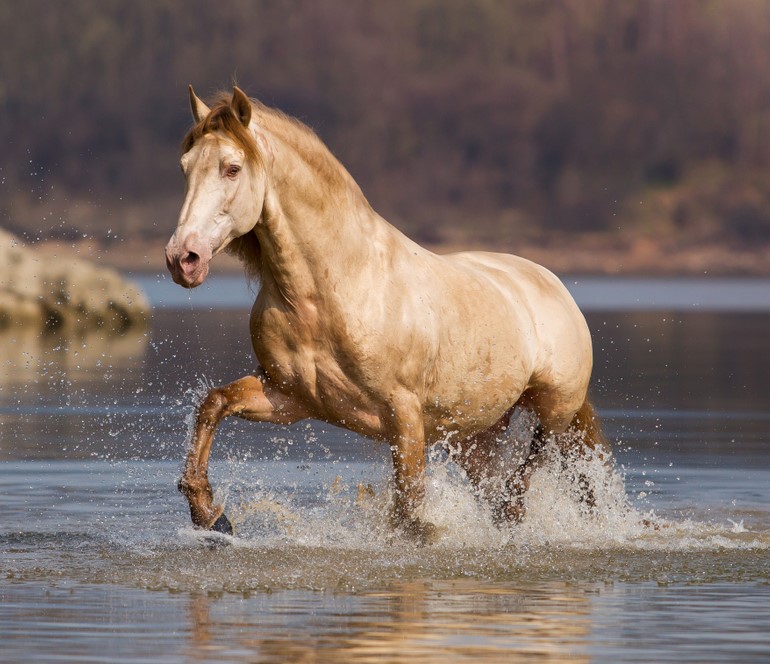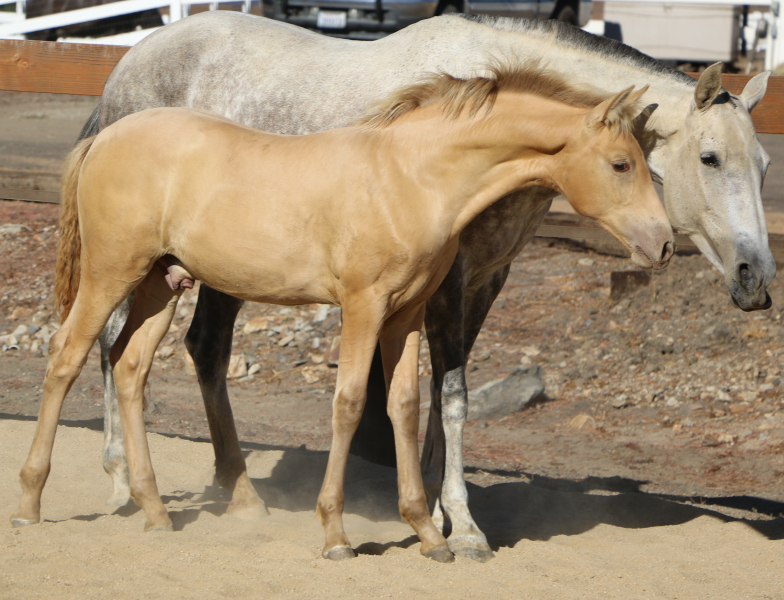Quick Summary

Click here for Price and Turnaround Time
Phenotype: Pearl is a coat color dilution that is characterized by a dilution of the coat, mane, and tail as well as a lightening of the skin, often resembling the champagne dilution.
Mode of Inheritance: Autosomal recessive
Alleles: N = Normal or non-pearl, Prl = Pearl
Breeds appropriate for testing: Andalusian, Lusitano, Paint Horse, Quarter Horse
Explanation of Results:
- Horses with N/N genotype will not display the pearl coat color and will not transmit this pearl dilution variant to their offspring.
- Horses with N/Prl genotype will not display the pearl coat color, but are carriers. They may transmit this pearl dilution variant to 50% of their offspring. Matings between two carriers (N/Prl) result in a 25% chance of producing pearl dilute offspring.
- Horses with Prl/Prl genotype will display the pearl coat color and will transmit this pearl dilution variant to all of their offspring.
Horse Coat Color Panel
$85 per animal
Full Color/Pattern Panel
$155 per animal
Sample Collection
Horse DNA tests are carried out using cells from the roots of a hair sample (roughly 20-40 hairs).
1. Grab about 10 hairs at the base.
2. Wrap the hairs around your finger and give it a quick pull.
3. Check the ends to make sure the pulled hairs have roots.
4. Repeat the process until you have collected about 20-40 hairs with intact roots.
5. You can choose different places on the mane or tail. NOTE: For foals, we recommend pulling all hairs from the tail only.
6. Tape the hairs to the submission form and fold the form along the dotted line to protect the sample. Do not use ziploc bags as they can cause condensation that allows mold to grow on the hair.
7. Place the folded form containing the sample in a paper envelope and mail it to the laboratory.

Six different coat color dilution phenotypes have been defined in horses: cream, dun, silver, champagne, mushroom, and pearl. Pearl is a rare dilution phenotype recognized in Quarter Horses and Spanish horse breeds such as Andalusians and Lusitanos. While, in Spanish horses, this dilution was always known as pearl, in Quarter Horses and Paints, it has been commonly known as "Barlink Factor". Research at the Veterinary Genetics Laboratory (VGL) on Quarter Horses and Paints identified a mutation associated with the "Barlink Factor" dilution. Further research has shown that the same mutation is present in Spanish horses with the pearl phenotype. The presence of this mutation in Quarter Horses and Paints likely reflects the Spanish horse ancestry of these modern breeds. To recognize that this mutation probably originated in Spanish horses, it is appropriate to name it pearl.
Pearl behaves as a recessive trait with respect to the hair color. One dose of the mutation does not change the coat color of black, bay, or chestnut horses. Two doses on a chestnut background produce a pale, uniform apricot color of body hair, mane and tail. Skin coloration is also pale. Pearl is known to interact with cream dilution to produce what is been called pseudo-double cream dilute phenotypes including pale skin and blue/green eyes. The mutation responsible for the pearl dilution is located in the gene SLC45A2 (c.985G>A), the same gene that contains the cream mutation. Horses with one copy of the cream allele and one copy of the pearl allele are thus correctly termed compound heterozygotes. The pearl mutation is though to disrupt the trafficking of pigment molecules to melanocytes, resulting in the pearl dilution.
Testing for this pearl dilution variant can help owners make breeding decisions. If the pearl phenotype is desired, it is advisable to breed two pearl horses to each other (Prl/Prl). Matings between two pearl carriers (Prl/N) will produce pearl offspring 25% of the time.

 Pearl
Pearl